Ramsey National Nature Reserve, Pembrokeshire, South Wales
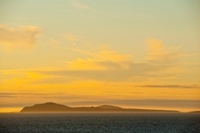
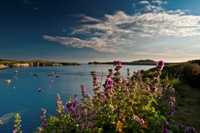
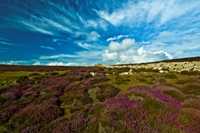
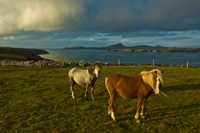
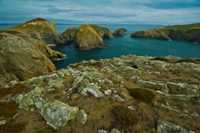
Designations: NNR, SSSI, SPA. Ramsey's coast forms part of the Pembrokeshire Marine SAC and part of the Pembrokeshire Coast National Park. Ramsey also has two Geoglogical Conservation Review (GCR) sites.
In spring and summer Ramsey Island, just off the coast of Pembrokeshire, is home to numerous breeding seabirds; among them are Guillemots, Razorbills, Kittiwakes and Fulmars. Peregrine Falcons, Choughs and Ravens also build their nests on Ramsey's high rocky cliffs.
Until quite recently, Ramsey had a problem with rats, which had come onshore from ships that sank close to the island.
Below: The island of Ramsey photographed from the Pembrokeshire coast early on a spring morning with mist still clinging to part of it
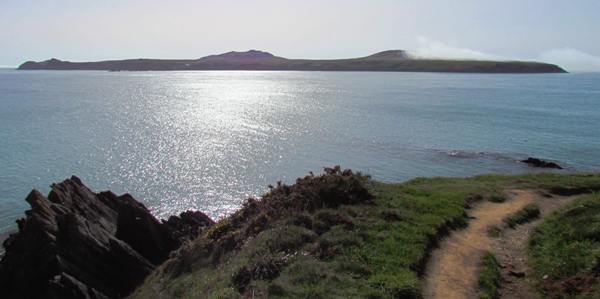
Because of the bird predation by rats there have been no Puffins nesting on Ramsey for a least 100 years. At the turn of the 21st Century rats were eradicated from the island, as also was the population of feral cats that had been brought in in an attempt to catch the rats - the old woman who swallowed a fly comes to mind!
Despite these problems a nesting colony of Manx Shearwaters had managed to cling on and is increasing in number following the departure of the rats and cats. Storm Petrels have also returned to Ramsey to nest, and this is a very encouraging sign raising hopes that Puffins will soon follow. Puffins are now regularly being sighted on the sea very close to the island, but so far they are stubbornly refusing to come ashore and view the ideal rabbit burrow accommodation that is just waiting for them. In an attempt to encourage the Puffins, RSPB has placed some 200 Puffin 'decoys' close to those parts of the coast where Puffins have recently been sighted - a ploy that has proven to be very successful in Scotland.
Below: One of 200 Puffin decoys being used on Ramsey to encourage real ones to return to breed there
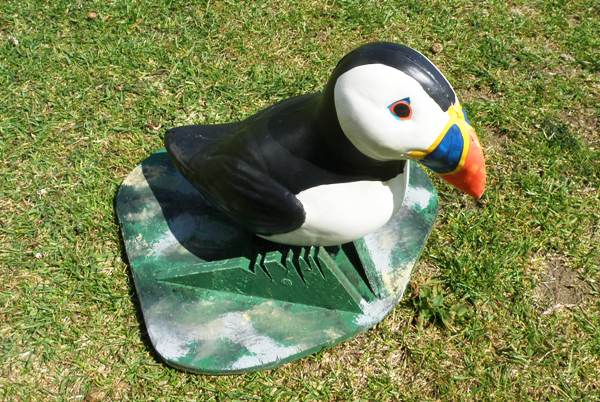
Ramsey has two hills: Carn Ysgubor (the smaller of the two) and Carn Llundain; the latter rises to 135m (450 ft). Both of these hills are over tyowards the high western cliffs, where there are also some impressive inlets and caves.
Ramsey supports the largest breeding colony of Atlantic Grey Seals in southern Britain, and during autum more than 400 seal pups are reared on the beaches and in the many caves on the island.
If you are interested in plants, then the island has something special to offer, too. The heathland is a mass of colour, starting with the flowering of the Bluebells in spring with other wildflowers following right through until the heather blooms in late summer.
The island of Ramsey is owned and managed by RSPB.
Below: The Thousand Islands ticket office in St. David's
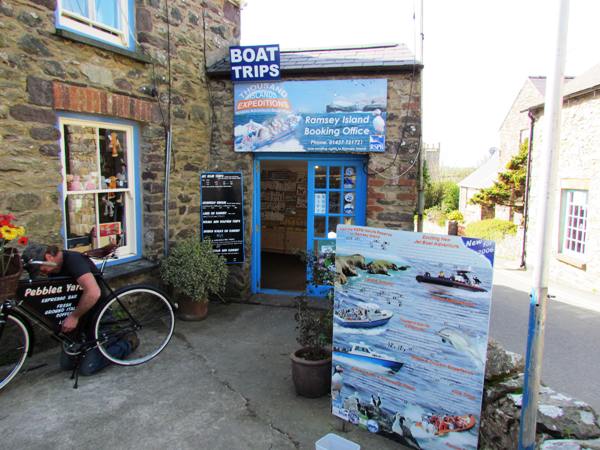
To Book a Boat Trip
RSPB endorses Thousand Islands Boat Trips, who have sole landing rights for Ramsey. Their office is situated just off Cross Square in St. David's - see picture on the right. The company operates a range of trips to Ramsey, and some of them are accompanied by an RSPB Guide. You can choose from a one and a half hour cruise around the island, an evening cruise to see the thousands of Manx Shearwaters returning to the island after a day at sea hunting for food, or to be dropped off on Ramsey to enjoy a ramble around the the 5.6km (3.5 mile) nature trail and to be picked up later in the day. There are also a number of guided walks run by an RSPB Guide at various times during the summer, but advance booking for these is absolutely essential.
Some of the boat trips combine a visit to see the vast colony of breeding Gannets on Grassholm with a subsequent visit to Ramsey.
The wildlife that you are likely to encounter at close quarters during these trips is not limited to birds; there is also a good chance of seeing Atlantic Grey Seals, Whales and Dolphins.
The team in the Thousand Islands Ticket Office are friendly, enthusiastic and happy to advise on the options available for enjoying the spectacular wildlife of these lovely islands. You can telephone them on: +44(0)1437 721721/721686.
More information...
Directions
Grid Ref: SM 598093 - Boat Departure Point
To get to St. David's from Haverfordwest take the A487, which passes the magnificent beach at Newgale. St. David's is well signed along this road. Alternatively, you can take the A487 south from Fishguard to St. David's, which is signed from the Ferry Port at Goodwick.
Boats for the islands of Ramsey and Grassholm depart from St Justinians Lifeboat Station, which is about 4km (2.5 miles) west of St David's. After first booking your tickets, take the road that leads down to the Cathedral from St David's city centre (yes, it is a very small city) and be ready for an almost immediate sharp right hand-turn signed to St. Justinians. Follow this narrow lane out of the city for about 3km (2 miles); the road ends at the boat departure point. There is a car park a short walk from the jetty and two parking laybys immediately above the jetty.
BOAT TRIPS TO THE ISLAND ARE WEATHER DEPENDENT, SO PLEASE CHECK THE FORECAST ON THE DAY YOU PLAN TO TRAVEL AND CONTACT THE BOAT COMPANY IF YOU HAVE ANY DOUBTS.
Below: The boat arriving at St. Justinians
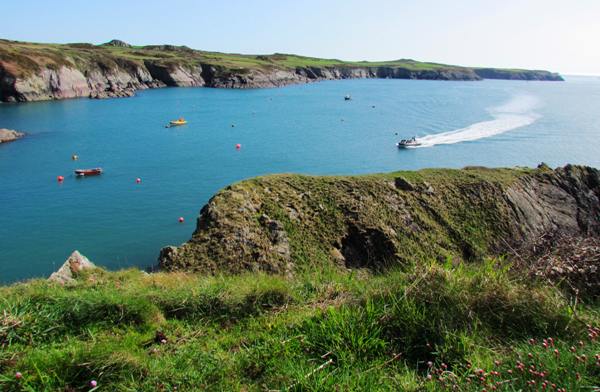
Access
There are steep steps down to the boat jetties on both the mainland and the island.
Some of the the nature trails on Ramsey are steep and rugged in places and not suitable for wheelchair users or for people with prams or pushchairs, but it is possible to avoid difficult terrain and walk on easy-going and clearly defined paths.
Good footwear is essential, because exposed rock on the paths can be slippery in wet weather.
Facilities
There are shops, pubs, cafés and toilets in St. David's, which is about 4km (2.5 miles) from the boat departure point at St Junstinians. On Ramsey itself there are public toilets and a shop selling a limited range of refreshments.
Description of Site
The profusion of wonderful wildflowers on Ramsey, and on the other islands off the Pembrokeshire coast, are a wonderful sight. From the early spring flowering of Bluebells Hyacynthoides non-scripta and the lovely Spring Squill Scilla verna there is a procession of brightly coloured flowers to enjoy all the way through to the end of summer.
Below: Golden Hair Lichen on a rock on Ramsey
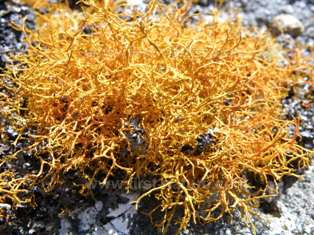
Sea Campion Silene uniflora blooms early, along with huge, dense mats of Thrift Armeria maritima which cling to the cliffs, and Common Dog Violets Viola rivinian). They are soon followed by Bird's-foot Trefoil Lotus corniculatus and Cat's-ear Hypochaeris radicata. On the rocky maritime heathland Red Fescue Festuca rubra and Sea Plantain Plantago maritima grow along with the heather, while the cliffs have plants such as Rock-samphire (Crithmum maritimum), Rock Sea-spurrey Spergularia rupicola and the increasingly rare Balm-leaved Figwort Scrophularia scorodonia. The pools in the heathland have two unusual plants: Water Plantain Alisma Plantago-aquatica and Three-lobed Crowfoot Ranunculus tripartitus. Another feature of the coastal cliffs of Ramsey is Golden Hair Lichen Teloschistes flavicans, which grows on rocks and stones. It is extremely sensitive to air pollution, and its status in the UK is vulnerable.
There are the remnants of an ancient population of Juniper bushes on Ramsey. Juniper is becoming more and more scarce in the UK, and unfortunately these bushes are also in danger of disappearing because they are situated so very close to the cliff edge.
Below: A Razorbill
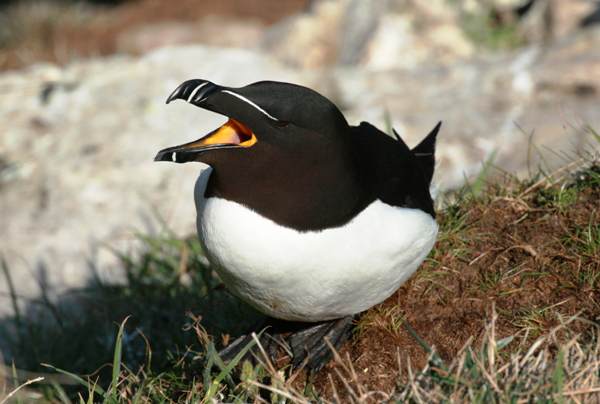
If it is the birds you have come to see, you will not be disappointed. In the early part of summer there are nesting Razorbills Alca torda and Guillemots Uria aalge as well as Kittiwakes Rissa tridactyla and Fulmars Fulmarus glaciali). The Razorbills and Guillemots are the first to leave after raising their young and are usually gone by the end of July, but the Kittiwakes and Fulmars remain until the end of August.
This is an important breeding ground for other birds, too, and you will find Peregrine Falcons Falco peregrinus and Choughs Pyrrhocorax pyrrhocorax nesting on the rocky cliffs at the western end of the island. The Peregrines prey on the young of the other seabirds in order to feed their families, but the Choughs hunt for grubs and insects on the maritime heathland, which is managed for their benefit and for that of another interesting species that nests on Ramsey - the Lapwing Vanellus vanellus which is also in serious decline because of loss of habitat.
Although only small numbers of Lapwings breed on Ramsey, in most years it is only breeding site for these birds in Pembrokeshire. Lapwings were once commonplace on the mainland, and I can still remember seeing vast flocks on newly ploughed fields when I was young. The kinds of damp fields and moorland where they nested then have been drained for agricultural purposes, and the resulting decline in their numbers has been dramatic. Oystercatchers Haematopus ostralegus, on the other hand, are thriving on the islands off the Pembrokeshire coast and there are breeding pairs on most of them during the summer.